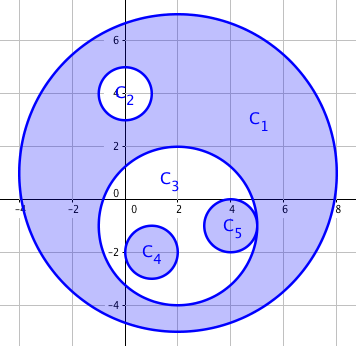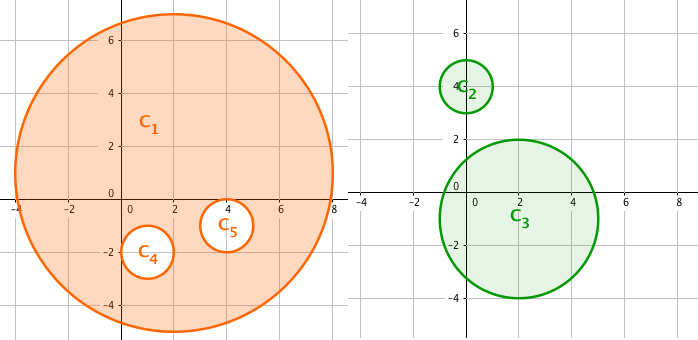codeforces 814D An overnight dance in discotheque
来源:互联网 发布:网络杀机 百度云 编辑:程序博客网 时间:2024/05/21 00:46
The crowdedness of the discotheque would never stop our friends from having fun, but a bit more spaciousness won't hurt, will it?
The discotheque can be seen as an infinite xy-plane, in which there are a total of n dancers. Once someone starts moving around, they will move only inside their own movement range, which is a circular area Ci described by a center (xi, yi) and a radius ri. No two ranges' borders have more than one common point, that is for every pair (i, j) (1 ≤ i < j ≤ n) either ranges Ci and Cj are disjoint, or one of them is a subset of the other. Note that it's possible that two ranges' borders share a single common point, but no two dancers have exactly the same ranges.
Tsukihi, being one of them, defines the spaciousness to be the area covered by an odd number of movement ranges of dancers who are moving. An example is shown below, with shaded regions representing the spaciousness if everyone moves at the same time.

But no one keeps moving for the whole night after all, so the whole night's time is divided into two halves — before midnight and after midnight. Every dancer moves around in one half, while sitting down with friends in the other. The spaciousness of two halves are calculated separately and their sum should, of course, be as large as possible. The following figure shows an optimal solution to the example above.

By different plans of who dances in the first half and who does in the other, different sums of spaciousness over two halves are achieved. You are to find the largest achievable value of this sum.
The first line of input contains a positive integer n (1 ≤ n ≤ 1 000) — the number of dancers.
The following n lines each describes a dancer: the i-th line among them contains three space-separated integers xi, yi and ri ( - 106 ≤ xi, yi ≤ 106, 1 ≤ ri ≤ 106), describing a circular movement range centered at (xi, yi) with radius ri.
Output one decimal number — the largest achievable sum of spaciousness over two halves of the night.
The output is considered correct if it has a relative or absolute error of at most 10 - 9. Formally, let your answer be a, and the jury's answer be b. Your answer is considered correct if  .
.
52 1 60 4 12 -1 31 -2 14 -1 1
138.23007676
80 0 10 0 20 0 30 0 40 0 50 0 60 0 70 0 8
289.02652413
The first sample corresponds to the illustrations in the legend.
贪心~
题目保证没有交点大于1个的一对圆,所以只有互相嵌套的圆。
对于一堆套起来的圆,显然在外面的圆面积更大,同样条件下,选择这些大圆更优。
所以手推一下……样例给得相当好,直接把我原来的错误解法hack掉了~
对于每个圆,我们O(n)地算一遍它能包含哪些圆,然后把能被包含的圆的层数+1。
ans=s(1)+s(2)-s(3)+s(4)-s(5)+...,即加上1号圆的面积,对于后面的圆偶数编号的加上,奇数编号的减去。
(考试的时候没有看清题居然也过了,我C题的rp估计都到D题了2333)
#include<cstdio>#include<iostream>#include<algorithm>#include<cmath>using namespace std;#define pi acos(-1)int n;double ans;struct node{double x,y,r;int num;}a[1001];bool operator < (node u,node v){if(u.r==v.r) return u.x==v.x ? u.y<v.y:u.x<v.x;return u.r>v.r;}bool han(node u,node v){return (u.x-v.x)*(u.x-v.x)+(u.y-v.y)*(u.y-v.y)<(u.r+v.r)*(u.r+v.r);}double cal(node u){return u.r*u.r*pi;}int main(){scanf("%d",&n);for(int i=1;i<=n;i++) scanf("%lf%lf%lf",&a[i].x,&a[i].y,&a[i].r);sort(a+1,a+n+1);for(int i=1;i<n;i++) for(int j=i+1;j<=n;j++) if(han(a[i],a[j])) a[j].num++;for(int i=1;i<=n;i++) if(!a[i].num) ans+=cal(a[i]); else if(a[i].num&1) ans+=cal(a[i]); else ans-=cal(a[i]);printf("%.8lf\n",ans);return 0;}- codeforces D. An overnight dance in discotheque
- codeforces 814D An overnight dance in discotheque
- codeforces 814D An overnight dance in discotheque(思维)
- Codeforces 814D An overnight dance in discotheque DP(树形)
- Codeforces 814D-An overnight dance in discotheque
- Codeforces 814D An overnight dance in discotheque【思维】
- codeforces 814 D An overnight dance in discotheque
- codeforces 814D An overnight dance in discotheque(贪心)
- Codeforces 814D-An overnight dance in discotheque 贪心
- Codeforces-814D An overnight dance in discotheque(贪心)
- D. An overnight dance in discotheque
- coderforces 814 D. An overnight dance in discotheque(贪心)
- [Codeforces 814D] An overnight dance in discotheque 树形dp,贪心
- codeforces 814D An overnight dance in discotheque(几何思维)
- CF#418 Div2 D. An overnight dance in discotheque
- Codeforces Round #418 (Div. 2) D. An overnight dance in discotheque(思维 贪心)
- Codeforces Round #418 (Div. 2) D. An overnight dance in discotheque
- Codeforces Round #418 (Div. 2) D. An overnight dance in discotheque 贪心
- 计算机原码、反码、补码详解
- 使用OpenCL+OpenCV实现图像卷积(二)
- Unity说明文档翻译-Script Execution Order Settings
- MySQL各个版本的区别
- 发送有序广播
- codeforces 814D An overnight dance in discotheque
- 【正一专栏】我的高考作文——在广州的乡下生活
- Jquery使用
- BS与CS的联系与区别
- CDN 资源分发性能优越的网站
- Java并发编程实战--读书笔记(目录)
- 揭秘Kaggle神器xgboost
- 新闻客户端
- 如何将多张图片合并成一个PDF文件


